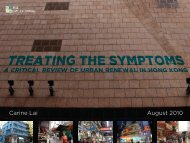Untitled - Civic Exchange
Untitled - Civic Exchange
Untitled - Civic Exchange
Create successful ePaper yourself
Turn your PDF publications into a flip-book with our unique Google optimized e-Paper software.
Chapter 5:<br />
Cleaner & More Efficient Road Transport<br />
but LNG port facilities could also be scaled to meet a range of demands. Another major market for the LNG<br />
would be created by the likely conversion of the Town gas system 171 to natural gas, which has a higher<br />
energy content. Replacing Town gas with natural gas would avoid the industrial emissions associated with<br />
producing Town gas in the HKSAR.<br />
Another possible source of natural gas is the existing pipeline from Hainan to Hong Kong. The pipeline is<br />
capable of carrying far more gas than it does at present. Exploration for gas reserves in the Hainan area is<br />
ongoing. If more gas is found, Guangdong and the HKSAR could bid for additional supplies. On a cost<br />
basis, bulk natural gas supplies by pipeline are highly competitive with liquid fuels and are far cleaner. If<br />
natural gas becomes widely available in the Pearl River Delta, it could transform the energy and<br />
environmental situation throughout the region.<br />
It is useful to remember that in the long run, Hong Kong's overall air quality depends in large part on what<br />
happens in Guangdong. Moving towards a regional energy based on natural gas is perhaps the most<br />
promising - and may be the only truly promising - long-term prospect for attaining safe air quality<br />
throughout the Pearl River Delta.<br />
Cleaner diesel and petrol<br />
While we feel that use of CNG and LNG should be encouraged, the introduction of both in Hong Kong<br />
will be restricted to particular types of vehicles for reasons of performance (e.g., LPG for lighter vehicles<br />
only) or re-fueling considerations (e.g., CNG). Hence, other alternatives must also be considered. 172<br />
The major advantage of cleaner diesel and petrol is that both involve little or no change to existing fuel<br />
distribution systems. As such, they offer obvious advantages with regard to ease of implementation -<br />
indeed, except for somewhat higher prices, drivers would hardly notice the difference. 173 Cleaner fuel<br />
options for Hong Kong include ultra low sulfur diesel (ULSD), oxygenated fuels, and bio-diesel. 174 For<br />
more detail on the specific costs and benefits of each, the reader is referred to the Cleaner Vehicles and<br />
Fuels report jointly published by <strong>Civic</strong> <strong>Exchange</strong> and the Asia Foundation. 175<br />
CTS3 notes the emissions reduction advantages of reformulated diesel, of which ULSD would be an<br />
advanced example. The study also stresses the advantages of diesel catalytic converters and particulate<br />
traps. Yet CTS3 says nothing about oxygenated petrol options and bio-diesel. 176 51<br />
171 Town gas has a chemical composition of carbon dioxide, carbon monoxide, methane, and hydrogen and is a<br />
product of the Hong Kong And China Gas Company Ltd (Towngas).<br />
172 Cleaner Vehicles and Fuels, a report published by <strong>Civic</strong> <strong>Exchange</strong> and the Asia Foundation on May 18, 2001,<br />
offers an assessment of the options available for Hong Kong. Several of the free-wheeling road vehicle systems<br />
discussed here might provide cost-effective measures for mitigating Hong Kong's transport-related air quality<br />
problems. The report is available at .<br />
173 The acceptability of any increase in prices for consumers (an internal cost) would be evaluated against the<br />
external benefits of better air quality.<br />
174 ULSD has a sulfur content under 0.005%. Oxygenated fuels are created by mixing ethanol with petrol, reducing<br />
aromatics and carbon monoxide. Bio-diesel is fuel derived from vegetable oils or animal fats that is used in<br />
compression ignition engines (like petroleum-derived diesel fuel). This is an older technology and was used in<br />
many areas of the world during World War II in times of diesel fuel shortage. Bio-diesel can also be mixed with<br />
diesel to reduce tailpipe emissions of particulates by 5-15% and hydrocarbons by 15-20%. <strong>Civic</strong> <strong>Exchange</strong> & the<br />
Asia Foundation (2001), Cleaner Vehicles and Fuels, Hong Kong.<br />
175<br />
<strong>Civic</strong> <strong>Exchange</strong> & the Asia Foundation (2001), Cleaner Vehicles and Fuels.<br />
176 Transport Department (1999), Third Comprehensive Transport Study: Strategic Environmental Impact<br />
Assessment.

















